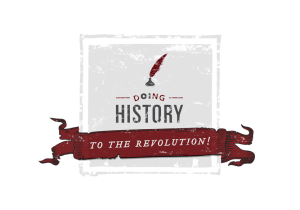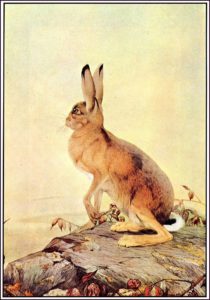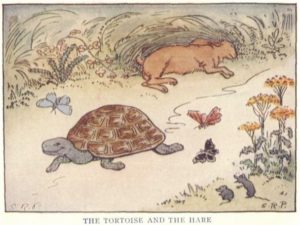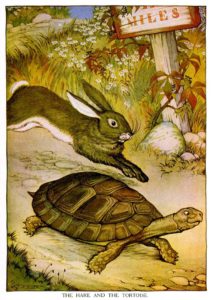Is it time to form a community for audio professionals in the humanities?
Podcasters in Pop Culture: Why Spoofing With the Right Equipment Matters
I was very excited to read that ABC purchased the rights to adapt StartUp into a television show called Alex, Inc. I couldn’t wait to see the show both because I loved the podcast and because I wanted to see how a podcast could be adapted for television. However, the purpose of the show is to provide a spoof on both start-up culture and podcasters. You can’t properly spoof something unless you understand it.
New Job, New Opportunities at the Omohundro Institute
I’m excited to announce that I’ve joined the staff at the Omohundro Institute of Early American History and Culture as its new Digital Projects Editor. This is a really exciting opportunity because it means long-term support for Ben Franklin’s World and the Doing History series and a chance to continue working and collaborating with the OI’s great staff of talented historians and professionals.
Over the last two years, the team at the Omohundro Institute has helped develop Ben Franklin’s World into a serious and professional media outlet for scholarly history. Their knowledge has played a major role in growing Ben Franklin’s World into a podcast that receives over 160,000 downloads per month and has garnered more than 2 million downloads in less than 3 years. Plus, the Doing History series has evolved into a dynamic series that not only shows the world how historians work and why our work matters, but encourages us to experiment with adapting our traditional modes of historical interpretation and communication to new media. (Thus far these experiments have proven successful as episodes in the Doing History: To the Revolution! series are the most downloaded episodes in the entire BFWorld catalog.)

It’s also an exciting opportunity because the Omohundro Institute is the preeminent organization in the world for early American historical scholarship. They do so much to support the work that we historians do through their fellowship and publication programs, conferences, and digital history initiatives and by challenging themselves and others to produce the best scholarship in the field. And now, Ben Franklin’s World and I get to be a BIGGER part of that work.
Going forward, listeners can still expect great interviews with scholars who work on different aspects of early American History. Episodes will continue to post on Tuesdays, just as they have been for over two and a half years, and listeners can also expect more multi-part series with narrative-style episodes.
For nearly 75 years, the Omohundro Institute has been committed to producing the best scholarship in early American history and I’m really looking forward to meeting the challenge of producing episodes that meet their high standards as well as the high standards the Ben Franklin’s World and Doing History audiences have come to expect. I’m excited to contribute to the Omohundro Institute’s long tradition of excellence.
Writing Early American History with Sound
 On April 18, 2017, a new preview episode of the Doing History: To the Revolution! series will post on Ben Franklin's World. It will be my most creative episode yet because it tells a story and uses sound to enhance the story I'm telling. The Omohundro Institute posted a piece I wrote about thinking through how to use sound to convey history on it's blog, Uncommon Sense.
I've been thinking a lot about horses. Specifically, what a Narragansett Pacer mare would have sounded like galloping on a dirt road in mid-April in the dead of night.[1]
On April 18, 2017, a new preview episode of the Doing History: To the Revolution! series will post on Ben Franklin's World. It will be my most creative episode yet because it tells a story and uses sound to enhance the story I'm telling. The Omohundro Institute posted a piece I wrote about thinking through how to use sound to convey history on it's blog, Uncommon Sense.
I've been thinking a lot about horses. Specifically, what a Narragansett Pacer mare would have sounded like galloping on a dirt road in mid-April in the dead of night.[1]
If I were a bystander, I might hear the faint noises of the labored breathing of the horse, the muffled commands of its rider, and a gallop that would all increase in volume until it peaked when I saw the horse and rider go by and heard its tack jingle. Then all of those sounds would fade into the distance as the horse made its way down the road.
If I were riding the horse, I'd hear the horse galloping on the dirt road differently. The horse's labored breathing, hoof beat, and tack jingle would be constant sounds in my ears. I'd also likely hear my clothes rustling in the wind created by our movement, if I listened to my experience fully.
The weather would also dictate the sounds I'd hear. Horses galloping on dry, dirt roads sound different than those galloping on wet, muddy roads. Plus, wind would make the dead of night seem alive. Instead of hearing the quiet stillness of the night, I'd hear the rustle of leaves and branches.
I've put a lot of thought into what will likely amount to about 10-20 seconds of audio in my next narrative-style podcast episode, "Paul Revere's Ride Through History," which will air as the next teaser episode of the Ben Franklin's World-Omohundro Institute's "Doing History: To the Revolution!" series on April 18, 2017.
With Digital Content Creation, the Tortoise Will Win the Race
 I don't get SnapChat. Why would you spend time creating content that people can only access for a limited period of time?
I shared this musing on Twitter and enjoyed exchanges that culminated in the fact that I'm old.
I don't get SnapChat. Why would you spend time creating content that people can only access for a limited period of time?
I shared this musing on Twitter and enjoyed exchanges that culminated in the fact that I'm old.
I may be a first-year millennial (I did in fact graduate high school in the year 2000), but I'm a member of the "Oregon Trail" part of the generation. The part that embraces new technology and still appreciates what came before it. I'm also a member of a profession that still lauds the book as the ultimate form of scholarly production. Books vary in quality, but they all take time to produce.
In the world I grew up in and the world I work in, it takes time and energy to produce content and preserve memories. These ideas and experiences shape the way I think about digital content and how it should be produced. They also make me a tortoise living and running in a hare's world.
The "Hare Approach" to Content Creation
 In comparison, "real" millennials and "post-millennials" have grown up using smartphones, tablets, apps, and hardware, like Snap's Spectacles, to easily create digital content. As a childhood friend pointed out, "now, basic content creation is nearly effortless." You can create content and preserve a memory in seconds.
In comparison, "real" millennials and "post-millennials" have grown up using smartphones, tablets, apps, and hardware, like Snap's Spectacles, to easily create digital content. As a childhood friend pointed out, "now, basic content creation is nearly effortless." You can create content and preserve a memory in seconds.
We live in a world full of digital content, but most of it's created quickly and it's not very good: bad blog posts, blurry photos, mundane status updates, and shaky videos. This mediocre content clogs the internet and means something only to those who created it and to those who understand the context of its creation.
Thinking about SnapChat within the context that content creation should be easy and effortless is when SnapChat started to make sense to me: The social app caters to people who want to create fast, effortless content. And thinking about SnapChat in this light has allowed me to appreciate how Snap may be doing our digital world a great service by making low-quality, hastily created content available only for a short period of time. Less clutter means more space for the great stuff to shine.
But what does the idea of creating fast, easy content on-the-go mean for the future of content creation? Has my belief that historians and other digital content producers should expend effort to produce high-quality, well thought out content become outmoded?
Should I morph into a hare?
I don't think so, at least not yet.
The "Tortoise Approach" To Content Creation
 If my ideas about content creation were outmoded then Amazon, Netflix, HBO, and now Apple wouldn't be investing HUGE sums of money in the production and curation of high-quality, niche programs like Game of Thrones.
If my ideas about content creation were outmoded then Amazon, Netflix, HBO, and now Apple wouldn't be investing HUGE sums of money in the production and curation of high-quality, niche programs like Game of Thrones.
All of these companies are producing high-quality shows unlike anything you can see on a traditional network to draw people to their subscription-based, digital content libraries. And if you're like me, you enjoy programs like Game of Thrones more than the programs on network television because of their production value. They involve many characters, have huge story arcs, and contain great special effects (hello, real-looking dragons & dire wolves). These high-quality shows also aren't beholden to the traditional time clock of network television-- episodes don't have to adhere to 30- and 60-minute time slots.
And premium digital networks aren't the only ones investing time and money into highly-produced content. Masterpiece Theater produces shows of similar quality for PBS. Think Downton Abbey, Victoria, and Poldark. They have less special effects than a show like Game of Thrones, but they all have high-quality production.
It's also interesting to compare the types of content networks are producing. HBO produces content like Game of Thrones and TrueBlood to appeal to fantasy lovers. People accustomed to good stories and who have a track record of paying for merchandise, books, games, and content. Masterpiece Theater's main goal is to drive people to support public broadcasting. They mainly produce mysteries and history-inspired programs. People who like history tend to enjoy culture, are civic-minded, and they have a track record of donating money to support the work of organizations like PBS and NPR.
Video-based content companies and companies that service digital video apps aren't the only companies investing in high-quality, digital content. So are traditional news outlets like The New York Times, The Washington Post, and NPR.
The New York Times and The Washington Post have publicly declared that they are redoubling their efforts to produce well-researched, long-form articles to differentiate themselves from other news outlets. They're banking on the fact that high-quality content will drive ad sales and subscriptions. They've also started audio divisions to lead people to their print content and to advertise their areas of expertise-- The Washington Post specializes in political podcasts; The New York Times produces podcasts about culture and they just released The Daily, a podcast that focuses on a big news story and leads you to its printed or digital newspaper.
NPR is also investing money in high-quality podcasts. The powerhouse networks that feed a lot of content to the national NPR network-- WBUR (Boston), WNYC (New York City), and WBEZ (Chicago)-- all have podcast and mobile divisions to produce apps like NPR One and great shows like Modern Love, Death, Sex, & Money, and Serial. Further, NPR-trained talent has started a whole host of new venture-funded podcast companies like Gimlet and Pineapple Street Media.
These new digital audio companies were founded to produce high-quality, on-demand audio content. Their funding models are based on three ideas:
1. High-quality, intellectually-driven content attracts listeners that advertisers will pay a premium to get access to because host-read podcast ads aren't yet regulated by the FCC, which means ads don't have to sound like ads, and the listeners the intellectually-driven content attracts tend to have disposable incomes.
2. If you have enough high-quality content, listeners will pay to access a back catalog like a subscription network. (These paid-subscription models are just starting to appear and will become more visible as these networks add to their content catalogs.)
3. Big companies recognize the value of high-quality content and are willing to pay networks to create custom content for them--like Open for Business by eBay, produced by Gimlet, and GE's podcast The Message, produced by Panoply.
Why the Tortoise Will Win in History Content Production
 Tortoises like me live in a hare's world. We look slow and outmoded in the way we produce digital content. But our goals are different from those of the hare.
Tortoises like me live in a hare's world. We look slow and outmoded in the way we produce digital content. But our goals are different from those of the hare.
In my case, I want to create content that resonates with people, that creates wide awareness about history, and that cultivates a sentiment within society that history and the work historians do is worth supporting. I'm, in fact, running a tortoise's race. So my ideas aren't outmoded, they're timely and they make sense.
I believe there is a place for the hare's content. Photos and images created quickly with smartphones are fun to produce and share. However, the hare's content won't build a lasting audience. Within the last decade we've seen Twitter, Facebook, and Instagram content producers who quickly built massive audiences only to watch those audiences dwindle and leave as new apps and social networks came out and interests changed. The quick and easy content they produced entertained only for a limited time.
History has staying power. People will always be interested in history because it helps us grapple with the big, existential questions of who we are and how we came to be who we are. This is why historians have always invested time and energy into producing content that lasts: books, articles, museum exhibits. And this tried-and-true method of investing time and effort in the content we produce should also be our approach in the digital world.
We should embrace the hare, borrow everything from its technological toolbox that will help us communicate history, and then adapt these tools to amplify our work. Because just like in the analog world that came before the digital world, quality work will rise to the top, be consumed by more people over time, and will last-- just like tortoises, which live an average of 200 years versus hares, which live an average of 5.5 years.


